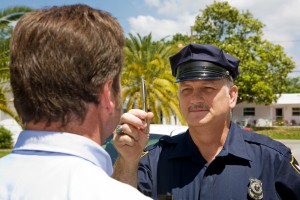
Since field sobriety tests can be nerve wracking even to some perfectly sober drivers, many people want to know the validity of the tests. After all, if the tests are not really that accurate, how can the officer convincingly argue that the driver was DUI? Those wanting to learn more about field sobriety tests and their corresponding accuracy should read on.
Horizontal Gaze Nystagmus Test (HGN)
Nystagmus is a natural shaking or jerking reaction of our eyes when looking too far into our periphery. Some individuals are diagnosed with higher levels of nystagmus that affects their vision permanently. In most other people, nystagmus can occur at less severe angles when the person is under the influence of alcohol or other mind-altering substances.
To test for nystagmus, the officer will ask that the driver follows the end of a pen light. If the officer notices any sort of jerking eye movement or shaking when the driver is looking at a still object less than 45 degrees off center, the U.S. National Highway Traffic Safety Administration (NHTSA) estimates within an 88 percent accuracy that the person has a BAC higher than the legal 0.08 limit.
Walk-and-Turn Test (WAT)
The walk and turn test attempts to divide the driver’s attention between mental and physical activities in order to reveal loss of balance, poor focusing skills or other indicators of intoxication. The NHTSA claims that the test is 79 percent accurate.
One-Leg Stand Test (OLS)
Drivers are instructed to hold one foot six inches off the ground for a minimum of 30 seconds. If the driver is unable to maintain balance or puts their foot down, the NHTSA estimates within 83 percent certainty that they are intoxicated.
The Validity of “The Big Three” and Other Tests
The NHTSA recognizes the three above field sobriety tests for their ability to accurately discern the suspected driver’s current intoxication levels. Put together, these tests paint a picture that the NHTSA claims is 91 percent accurate.
However, in isolation each test may carry a different amount of statistical validity. Drivers performing well in one test and inconsistently poor in another may not satisfy the purported 91 percent accuracy.
The courts nevertheless typically compile the stated field sobriety test results with the totality of information as provided by the officer, making allegations that the test was invalid often your word against the officer’s. An attorney experienced in representing DUI in Pennsylvania cases may be capable of providing additional facts or interpretations of the law to further contest the officer’s claims.
If you have been accused of a DUI in Pennsylvania either through a field sobriety test or other means, then your best solution is to procure an experienced Pennsylvania DUI lawyer. The Law Offices of Steven E. Kellis can offer the representation you need to fight for your rights and ensure that an accurate picture is portrayed to the courts. Call us now; we offer free consultations and are available to respond 24/7.